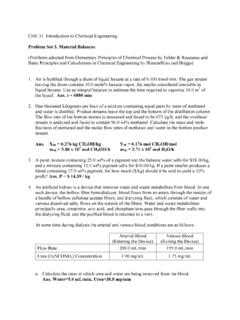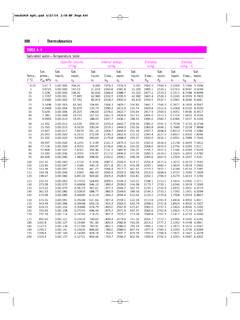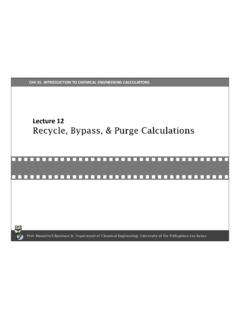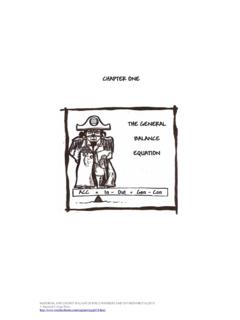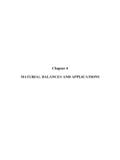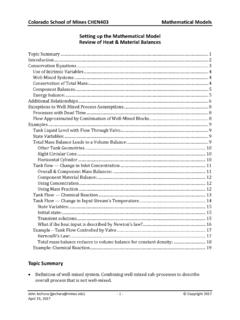Transcription of CHE 31. INTRODUCTION TO CHEMICAL ENGINEERING …
1 CHE 31. INTRODUCTION TO CHEMICAL ENGINEERING CALCULATIONSL ecture 9 Solving material Balances Problems Involving Non-Reactive ProcessesProf. Manolito E Bambase Jr. Department of CHEMICAL ENGINEERING . University of the Philippines Los Ba os LECTURE 9. Solving material balance Problems Involving Non-Reactive ProcessesProf. Manolito E Bambase Jr. Department of CHEMICAL ENGINEERING . University of the Philippines Los Ba os SLIDE2 Component and Overall material BalancesConsider a steady-state distillation process,LECTURE 9. Solving material balance Problems Involving Non-Reactive ProcessesProf. Manolito E Bambase Jr.
2 Department of CHEMICAL ENGINEERING . University of the Philippines Los Ba os SLIDE3 Component and Overall material BalancesSince the process is at steady-state condition and no CHEMICAL reaction is involved, the material balance equation becomesInput = OutputThis balance equation can be applied total mass entering and leaving the of individual component entering and leaving the 9. Solving material balance Problems Involving Non-Reactive ProcessesProf. Manolito E Bambase Jr. Department of CHEMICAL ENGINEERING . University of the Philippines Los Ba os SLIDE4 Component and Overall material BalancesTotal Mass (Overall material balance )m1= m2+ m3 Component A BalancemA1= mA2+ mA3m1xA1= m2xA2+ m3xA3 Component B BalancemB1= mB2+ mB3m1xB1= m2xB2+ m3xB3 LECTURE 9.
3 Solving material balance Problems Involving Non-Reactive ProcessesProf. Manolito E Bambase Jr. Department of CHEMICAL ENGINEERING . University of the Philippines Los Ba os SLIDE5 Component and Overall material BalancesFor the given process, 3 material balance equations can be written:Total balance :m1= m2+ m3(E1)A- balance :mA1= mA2+ mA3(E2)B- balance :mB1= mB2+ mB3(E3)Are these material balances independent equations?If (E1) and (E2) are added, what does the resulting equation represents?LECTURE 9. Solving material balance Problems Involving Non-Reactive ProcessesProf. Manolito E Bambase Jr. Department of CHEMICAL ENGINEERING .
4 University of the Philippines Los Ba os SLIDE6 Component and Overall material BalancesConsider the unsteady-state extraction process:Extraction is a physical process in which a component of a mixture is extracted using an immiscible 9. Solving material balance Problems Involving Non-Reactive ProcessesProf. Manolito E Bambase Jr. Department of CHEMICAL ENGINEERING . University of the Philippines Los Ba os SLIDE7 Component and Overall material BalancesWriting the material balance equations:Total balance :(Acc)T= m1+ m2 m3 m4A- balance :(Acc)A= mA1 mA3B- balance :(Acc)B= mB1 mB3 mB4C- balance :(Acc)C= mC2 mC4 The total balance can also be obtained by adding the last 3 equations and is no longer 9.
5 Solving material balance Problems Involving Non-Reactive ProcessesProf. Manolito E Bambase Jr. Department of CHEMICAL ENGINEERING . University of the Philippines Los Ba os SLIDE8 Number of Independent material balance Equations in Process without CHEMICAL ReactionFor processes with no CHEMICAL reaction,Nm= NiwhereNm= number of independent material balance total number of CHEMICAL species (or components) involved in the 9. Solving material balance Problems Involving Non-Reactive ProcessesProf. Manolito E Bambase Jr. Department of CHEMICAL ENGINEERING . University of the Philippines Los Ba os SLIDE9 Example 9 1.
6 Mixing of Methanol-Water MixturesTwo methanol-water mixtures are contained in separate tanks. The first mixture contains wt% methanol and the second contains wt% methanol. If 200 kg of the first mixture is combined with 150 kg of the second, what are the mass and composition of the product?LECTURE 9. Solving material balance Problems Involving Non-Reactive ProcessesProf. Manolito E Bambase Jr. Department of CHEMICAL ENGINEERING . University of the Philippines Los Ba os SLIDE10 Example 9 1. Mixing of Methanol-Water MixturesStep 1. Draw a flowchart to visually organize the 9. Solving material balance Problems Involving Non-Reactive ProcessesProf.
7 Manolito E Bambase Jr. Department of CHEMICAL ENGINEERING . University of the Philippines Los Ba os SLIDE11 Example 9 1. Mixing of Methanol-Water MixturesStep 2. Determine the degrees of freedom (DF)Number of unknowns (U): 3 unknowns (m3, xM3, xW3)Number of independent equations (V): material balances:2 equationsphysical constraint: 1 equation ( x = )--------------------------------total independent equations3 equationsDF = U V = 3 3 = 0, the problem is solvableLECTURE 9. Solving material balance Problems Involving Non-Reactive ProcessesProf. Manolito E Bambase Jr. Department of CHEMICAL ENGINEERING . University of the Philippines Los Ba os SLIDE12 Example 9 1.
8 Mixing of Methanol-Water MixturesStep 3. Write down the equationsMaterial Balances (Steady-State, Non-Reactive Process):Total balance :m1+ m2= m3 Methanol- balance :m1xM1+ m2xM2= m3xM3 Water- balance :m1xW1+ m2xW2= m3xW3(choose only 2 equations since one of them is no longer independent)Physical Constraint (applied to mixture 3):xM3+ xW3= 9. Solving material balance Problems Involving Non-Reactive ProcessesProf. Manolito E Bambase Jr. Department of CHEMICAL ENGINEERING . University of the Philippines Los Ba os SLIDE13 Example 9 1. Mixing of Methanol-Water MixturesStep 4. Solve the unknowns (m3, xM3, xW3)Always start with the equation with the least number of unknowns if possible and minimize solving equations balance (m3) Methanol balance (xM3) Physical Constraint (xW3)LECTURE 9.
9 Solving material balance Problems Involving Non-Reactive ProcessesProf. Manolito E Bambase Jr. Department of CHEMICAL ENGINEERING . University of the Philippines Los Ba os SLIDE14 Example 9 1. Mixing of Methanol-Water MixturesStep 4. Solve the unknowns (m3, xM3, xW3)Total balance :m3= (200 kg) + (150 kg)m3= 350 kgCH3OH balance :(200 kg)( ) + (150 kg)( ) = (350 g)xM3xM3= constraint:xW3= xM3= 1 9. Solving material balance Problems Involving Non-Reactive ProcessesProf. Manolito E Bambase Jr. Department of CHEMICAL ENGINEERING . University of the Philippines Los Ba os SLIDE15 Example 9 2. Mixing of Ethanol-Water MixturesThree hundred gallons of a mixture containing wt% ethanol and 25% water (mixture specific gravity = ) and a quantity of a wt% ethanol-60% water mixture (SG= ) are blended to produce a mixture containing wt% ethanol.
10 Determine the required volume of the 40% require = 207 galLECTURE 9. Solving material balance Problems Involving Non-Reactive ProcessesProf. Manolito E Bambase Jr. Department of CHEMICAL ENGINEERING . University of the Philippines Los Ba os SLIDE16 Example 9 3. Humidification of AirA stream of humid air containing mole% H2O(v)and the balance dry air is to be humidified to a water content of mole% H2O(v). For this purpose, liquid water is fed through a flow meter and evaporated into the air stream. The flow meter reading, R, is 95. The only available calibration data for the flow meter are two points, indicating that readings of R=15 and R=50 correspond to flow rates V = ft3/h and V = ft3/h, respectively.
